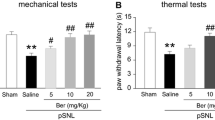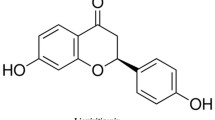Abstract
The study comprises exploring the effects of saponins from Tribulus terrestris (TT) in attenuating the neuropathic pain caused by vincristine (100 μg/ml i.p.) for 10 days (in two 5 day cycles with 2 days pause). Mechanical hyperalgesia and allodynia were assessed by Randall–Sellitto and electronic von Frey tests, respectively. Chemical- induced nociception was assessed by formalin test. Neurophysiological effect of the extract was evaluated by recording sciatic functional index (SFI) on the test days (7, 10, 14, and 21) and sciatic nerve conduction velocity test (SNCV) on the last day. Inflammatory mediators (TNF-α, IL-1β, and IL-6) in both sciatic nerve and brain and brain neurotransmitters, glutamate and aspartate, were measured to support the behavioral response. The saponins of TT-treated group were found to be effective in the behavioral experiments, implying its activity both centrally and peripherally in attenuating pain. The inflammatory mediators in both sciatic nerve and brain (TNF-α, IL-1β, and IL-6) were found to be attenuated with TT saponin treatment in comparison to vincristine-treated group, indicating its anti-inflammatory property. The excitatory neurotransmitters, l-glutamic acid and l-aspartic acid, were also found to be attenuated with TT saponins, implying restoration of neuronal damage and synaptic activity caused by high amount of glutamate due to excess TNF-α in brain and reversing the nociceptive threshold lowered due to aspartate. Thus, TT(S) is peripherally and centrally active in lowering the inflammatory mediators, reversing the neuronal damage and increasing the nociceptive threshold caused due to peripheral neuropathy.


Similar content being viewed by others
References
Babu CS, Sunil AG, Vasanthi HR et al (2007) Development and validation of an HPTLC method for simultaneous estimation of excitatory neurotransmitters in rat brain. J Liq Chromatogr Relat Technol 30:2891–2902. https://doi.org/10.1080/10826070701588760
Bain JR, Mackinnon SE, Hunter DA (1989) Functional evaluation of complete sciatic, peroneal, and posterior tibial nerve lesions in the rat. Plast Reconstr Surg 83:129–136. https://doi.org/10.1097/00006534-198901000-00024
Bennett GJ, **e YK (1988) A peripheral mononeuropathy in rat that produces disorders of pain sensation like those seen in man. Pain 33:87–107. https://doi.org/10.1016/0304-3959(88)90209-6
Beyreuther B, Callizot N, Stöhr T (2006) Antinociceptive efficacy of lacosamide in a rat model for painful diabetic neuropathy. Eur J Pharmacol 539:64–70. https://doi.org/10.1016/j.ejphar.2006.04.009
Boccella S, Vacca V, Errico F, Marinelli S, Squillace M, Guida F, Di Maio A, Vitucci D, Palazzo E, De Novellis V, Maione S, Pavone F, Usiello A et al (2015) D-aspartate modulates nociceptive-specific neuron activity and pain threshold in inflammatory and neuropathic pain condition in mice. BioMed Res Int. https://doi.org/10.1155/2015/905906
Brown CJ, Mackinnon SE, Evans PJ et al (1989) Self-evaluation of walking-track measurement using a sciatic function index. Microsurgery 10:226–235. https://doi.org/10.1002/micr.1920100317
Clark IA, Vissel B (2016) Excess cerebral TNF causing glutamate excitotoxicity rationalizes treatment of neurodegenerative diseases and neurogenic pain by anti-TNF agents. J Neuroinflamm 13:236. https://doi.org/10.1186/s12974-016-0708-2
de Medinaceli L (1988) Functional consequences of experimental nerve lesions: effects of time, location, and extent of damage. Exp Neurol 100:154–165. https://doi.org/10.1016/0014-4886(88)90208-7
Dinchev D, Janda B, Evstatieva L et al (2008) Distribution of steroidal saponins in Tribulus terrestris from different geographical regions. Phytochemistry 69:176–186. https://doi.org/10.1016/j.phytochem.2007.07.003
Dougherty PM, Cata JP, Burton AW et al (2007) Dysfunction in multiple primary afferent fiber subtypes revealed by quantitative sensory testing in patients with chronic vincristine-induced pain. J Pain Symptom Manage 33:166–179. https://doi.org/10.1016/j.jpainsymman.2006.08.006
Geis C, Beyreuther BK, Stöhr T, Sommer C (2011) Lacosamide has protective disease modifying properties in experimental vincristine neuropathy. Neuropharmacology 61:600–607. https://doi.org/10.1016/j.neuropharm.2011.05.001
Goranova T, Bozhanov S, Lozanov V et al (2015) Changes in gene expression of CXCR4, CCR7 and BCL2 after treatment of breast cancer cells with saponin extract from Tribulus terrestris. Neoplasma 62:27–33. https://doi.org/10.4149/neo_2015_004
Greeshma N, Prasanth KG, Balaji B (2015) Tetrahydrocurcumin exerts protective effect on vincristine induced neuropathy: behavioral, biochemical, neurophysiological and histological evidence. Chem Biol Interact 238:118–128. https://doi.org/10.1016/j.cbi.2015.06.025
Han Y, Smith MT (2013) Pathobiology of cancer chemotherapy-induced peripheral neuropathy (CIPN). Front Pharmacol. https://doi.org/10.3389/fphar.2013.00156
Hara K, Haranishi Y, Terada T et al (2014) Effects of intrathecal and intracerebroventricular administration of luteolin in a rat neuropathic pain model. Pharmacol Biochem Behav 125:78–84. https://doi.org/10.1016/j.pbb.2014.08.011
Hassan HS, Sule MI, Musa AM et al (2012) Anti-inflammatory activity of crude saponin extracts from five Nigerian medicinal plants. Afr J Tradit Complement Altern Med 9:250–255. https://doi.org/10.4314/ajtcam.v9i2.10
Heidari MR, Mehrabani M, Pardakhty A et al (2007) The analgesic effect of Tribulus terrestris extract and comparison of gastric ulcerogenicity of the extract with indomethacin in animal experiments. Ann N Y Acad Sci 1095:418–427. https://doi.org/10.1196/annals.1397.045
Hunskaar S, Hole K (1987) The formalin test in mice: dissociation between inflammatory and non-inflammatory pain. Pain 30:103–114. https://doi.org/10.1016/0304-3959(87)90088-1
Jaggi AS, Singh N (2010) Differential effect of spironolactone in chronic constriction injury and vincristine-induced neuropathic pain in rats. Eur J Pharmacol 648:102–109. https://doi.org/10.1016/j.ejphar.2010.08.050
Jaggi AS, Singh N (2012) Analgesic potential of intrathecal farnesyl thiosalicylic acid and GW 5074 in vincristine-induced neuropathic pain in rats. Food Chem Toxicol 50:1295–1301. https://doi.org/10.1016/j.fct.2012.01.038
Kataoka K, Hara K, Haranishi Y et al (2013) The antinociceptive effect of SNAP5114, a gamma-aminobutyric acid transporter-3 inhibitor, in rat experimental pain models. Anesth Analg 116:1162–1169. https://doi.org/10.1213/ANE.0b013e318282dda7
Kiguchi N, Maeda T, Kobayashi Y et al (2009) Chapter 14 involvement of inflammatory mediators in neuropathic pain caused by vincristine. In: International review of neurobiology, pp 179–190. https://doi.org/10.1016/S0074-7742(09)85014-9
Kim YH, Back SK, Davies AJ et al (2012) TRPV1 in GABAergic interneurons mediates neuropathic mechanical allodynia and disinhibition of the nociceptive circuitry in the spinal cord. Neuron 74:640–647. https://doi.org/10.1016/j.neuron.2012.02.039
Kostova I, Dinchev D (2005) Saponins in tribulus terrestris—chemistry and bioactivity. Phytochem Rev 4:111–137. https://doi.org/10.1007/s11101-005-2833-x
Kukkar A, Singh N, Jaggi AS (2013) Neuropathic pain-attenuating potential of aliskiren in chronic constriction injury model in rats. JRAAS 14:116–123. https://doi.org/10.1177/1470320312460899
Lee HH, Ahn EK, Hong SS, Oh JS (2017) Anti-inflammatory effect of Tribulusamide D isolated from Tribulus terrestris in lipopolysaccharide-stimulated RAW264.7 macrophages. Mol Med Rep 16:4421–4428. https://doi.org/10.3892/mmr.2017.7208
Lopes LS, Pereira SS, Silva LL et al (2009) Antinociceptive effect of topiramate in models of acute pain and diabetic neuropathy in rodents. Life Sci 84:105–110. https://doi.org/10.1016/j.lfs.2008.11.005
Luiz AP, Moura JDÁ, Meotti FC et al (2007) Antinociceptive action of ethanolic extract obtained from roots of Humirianthera ampla Miers. J Ethnopharmacol 114:355–363. https://doi.org/10.1016/j.jep.2007.08.016
Muthuraman A, Singh N (2012) Neuroprotective effect of saponin rich extract of Acorus calamus L. in rat model of chronic constriction injury (CCI) of sciatic nerve-induced neuropathic pain. J Ethnopharmacol 142:723–731. https://doi.org/10.1016/j.jep.2012.05.049
Muthuraman A, Jaggi AS, Singh N, Singh D (2008) Ameliorative effects of amiloride and pralidoxime in chronic constriction injury and vincristine induced painful neuropathy in rats. Eur J Pharmacol 587:104–111. https://doi.org/10.1016/j.ejphar.2008.03.042
Muthuraman A, Singh N, Jaggi AS (2011) Protective effect of Acorus calamus L. in rat model of vincristine induced painful neuropathy: an evidence of anti-inflammatory and anti-oxidative activity. Food Chem Toxicol 49:2557–2563. https://doi.org/10.1016/j.fct.2011.06.069
Okamoto K, Martin DP, Schmelzer JD et al (2001) Pro- and anti-inflammatory cytokine gene expression in rat sciatic nerve chronic constriction injury model of neuropathic pain. Exp Neurol 169:386–391. https://doi.org/10.1006/exnr.2001.7677
Olmos G, Lladó J (2014) Tumor necrosis factor alpha: a link between neuroinflammation and excitotoxicity. Mediators Inflamm 2014:1–12. https://doi.org/10.1155/2014/861231
Park YJ, Cho YR, Oh JS, Ahn EK (2017) Effects of Tribulus terrestris on monosodium iodoacetate-induced osteoarthritis pain in rats. Mol Med Rep 16:5303–5311. https://doi.org/10.3892/mmr.2017.7296
Randall LO, Selitto JJ, Valdes J (1957) Anti-inflammatory effects of xylopropamine. Arch Int Pharmacodyn Ther 113:233–249
Ranjithkumar R, Prathab Balaji S, Balaji B et al (2012) Standardized aqueous Tribulus terrestris (Nerunjil) extract attenuates hyperalgesia in experimentally induced diabetic neuropathic pain model: Role of oxidative stress and inflammatory mediators. Phyther Res 27:1646–1657. https://doi.org/10.1002/ptr.4915
Scholz J, Woolf CJ (2007) The neuropathic pain triad: neurons, immune cells and glia. Nat Neurosci 10:1361–1368. https://doi.org/10.1038/nn1992
Sen O, Sayilgan NC, Tutuncu AC et al (2016) Evaluation of sciatic nerve damage following intraneural injection of bupivacaine, levobupivacaine and lidocaine in rats. Brazilian J Anesthesiol (English Ed) 66:272–275. https://doi.org/10.1016/j.bjane.2014.09.012
Sisignano M, Baron R, Scholich K, Geisslinger G (2014) Mechanism-based treatment for chemotherapy-induced peripheral neuropathic pain. Nat Rev Neurol 10:694–707. https://doi.org/10.1038/nrneurol.2014.211
Starobova H, Vetter I (2017) Pathophysiology of chemotherapy-induced peripheral neuropathy. Front Mol Neurosci. https://doi.org/10.3389/fnmol.2017.00174
Taiwo YO, Levine JD (1989) Contribution of guanine nucleotide regulatory proteins to prostaglandin hyperalgesia in the rat. Brain Res 492:400–403. https://doi.org/10.1016/0006-8993(89)90929-3
Tsuda M, Shigemoto-Mogami Y, Koizumi S et al (2003) P2X4 receptors induced in spinal microglia gate tactile allodynia after nerve injury. Nature 424:778–783. https://doi.org/10.1038/nature01786
Varejão ASP, Cabrita AM, Meek MF et al (2004) Functional and morphological assessment of a standardized rat sciatic nerve crush injury with a non-serrated clamp introduction. J Neurotrauma 21:1652–1670. https://doi.org/10.1089/neu.2004.21.1652
Weng HR, Cordella JV, Dougherty PM (2003) Changes in sensory processing in the spinal dorsal horn accompany vincristine-induced hyperalgesia and allodynia. Pain 103:131–138. https://doi.org/10.1016/S0304-3959(02)00445-1
Wu XF, Liu WT, Liu YP et al (2011) Reopening of ATP-sensitive potassium channels reduces neuropathic pain and regulates astroglial gap junctions in the rat spinal cord. Pain 152:2605–2615. https://doi.org/10.1016/j.pain.2011.08.003
**ao WH, Bennett GJ (2008) Chemotherapy-evoked neuropathic pain: abnormal spontaneous discharge in A-fiber and C-fiber primary afferent neurons and its suppression by acetyl-l-carnitine. Pain 135:262–270. https://doi.org/10.1016/j.pain.2007.06.001
Zhang S, Li H, Xu H, Yang SJ (2010a) Effect of gross saponins of Tribulus terrestris on cardiocytes impaired by adriamycin. Yaoxue Xuebao 45:31–36
Zhang S, Li H, Yang S (2010b) Tribulosin protects rat hearts from ischemia/reperfusion injury. Acta Pharmacol Sin 31:671–678. https://doi.org/10.1038/aps.2010.45
Acknowledgements
The authors would like to thank PSG Sons and Charities for providing all the facilities to carry out the work and Sami Labs, Bangalore, India, for gifting 20% saponin enriched Tribulus terrestris as a gift sample, Dr. Sivaram Hariharan (Professor, Department of Pharmaceutical Chemistry, PSG College of Pharmacy) for advising with language help for scientific writing with appropriate grammars to communicate the work and Department of Biotechnology (DBT) Govt of India for funding the work.
Funding
The study was funded by Department of Biotechnology (DBT), Govt of India (Grant Number BT/467/NE/TBP/2013).
Author information
Authors and Affiliations
Corresponding author
Ethics declarations
Conflict of interest
The authors declare that they have no conflict of interest.
Ethical approval
All procedures performed in studies involving animals were in accordance with the ethical standards of the institution or practice at which the studies were conducted (Reg. No. 158/PO/ReBi/SL/99/CPCSEA).
Rights and permissions
About this article
Cite this article
Gautam, M., Ramanathan, M. Saponins of Tribulus terrestris attenuated neuropathic pain induced with vincristine through central and peripheral mechanism. Inflammopharmacol 27, 761–772 (2019). https://doi.org/10.1007/s10787-018-0502-0
Received:
Accepted:
Published:
Issue Date:
DOI: https://doi.org/10.1007/s10787-018-0502-0




